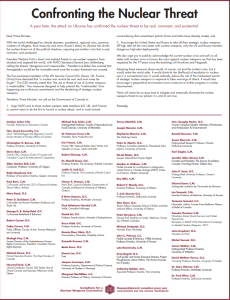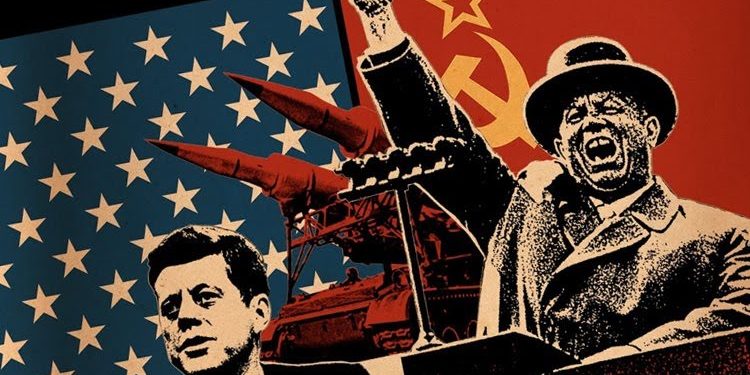We have to believe in a world without war – and science should lead the way
JOHN POLANYI
Published in the Globe and Mail
John Polanyi is a professor emeritus at the University of Toronto who won the 1986 Nobel Prize in chemistry. This piece is adapted from remarks made at Toronto’s Massey College on Nov. 3.
Today, university appointments are reviewed carefully. That was not so much the case in 1956 when the University of Toronto decided to take a chance on me.
The institution was unstinting in its help. Donald LeRoy, then the head of chemistry, deflected his top student, Ken Cashion, in my direction. Harry Welsh – LeRoy’s counterpart in physics – showed me how to align mirrors to collect infrared radiation. This was in response to a suggestion from Gerhard Herzberg, a Canadian who went on to win the Nobel Prize for Chemistry, that chemical reactions might emit radiation characteristic of the motions of the reacting atoms.
Space in the chemistry department was tight, but I was offered an empty broom closet in the nearby Wallberg Building. An infrared detector was hooked up to our hydrogen-plus-chlorine reactor. With the gas flows turned on, the detector signalled unmistakable infrared emission. I remember Ken Cashion, a recently ordained priest from St. Michael’s College, pounding on the instrument’s casing and shouting the most extreme expletive he could muster: “Holy crowbar.”
I went in search of other venturesome students, and learned of a student-faculty group opposing the stationing of U.S. nuclear weapons in Canada. I joined them in writing an appeal to prime minister John Diefenbaker that I circulated to my new chemistry colleagues.
Fortunately, they were supportive. Better still, Diefenbaker spent an hour with us in Ottawa. The Globe and Mail, surprised by this eruption of politics in academe, ran our petition on its front page. Public debate ensued. Governments fell. Surprisingly, the weapons ban survived, as it does today.
Then came an invitation from England – signed, magnificently, “The Earl Bertrand Russell” – to participate in a discussion of the nuclear threat, under the sponsorship of the international Pugwash Conferences on Science and World Affairs. The meeting was to be held in Moscow in December, 1960. I, the new Canadian, would be my country’s delegate.
I turned to my boss, Vincent Bladen – the University of Toronto’s dean of the Faculty of Arts and Sciences at the time – for advice. Should I accept the hospitality of the Kremlin? The question was forwarded on to Ottawa, which replied promptly: “Don’t go.”
An unfazed Bladen came back to me with a plane ticket to Moscow so I would not feel beholden to the Soviet Union. I do remain beholden today – but to U of T.
The meeting marked the beginning of my long association with Pugwash. The conference brought together scientists to debate the level of nuclear armaments needed for deterrence. Stable deterrence, it was thought, could ensure peace.
Today, we are less confident. To work, threats and counterthreats must be real. If they are real, in times of crisis, they may lead to war.
The 1960 Moscow meeting was timely, coming shortly before the Cuban Missile Crisis of 1962, during which the world teetered on the brink of nuclear war.
Today, I believe only radical actions can save us. We must reshape history. Ours must be an age of abolition; it has already been marked by an end to slavery, and we must soon see an end to female servitude, an end to environmental degradation and, above all, an end to threats of mass destruction.
None of this will occur without a clamour for change.
Science requires us to see the world anew. A guide to doing so came from H.G. Wells in his science-fiction novel, The World Set Free. It was published in 1914, just before the start of the First World War – but in the face of disaster, he saw hope.
The situation resembled that of today. The threat then, as now, derived from science. But Wells saw beyond tanks and machine guns. He had read the record of research then being conducted at McGill University by Ernest Rutherford, and was aware that atoms could break apart. In this finding, he saw the ultimate weapon of war. He named the weapon an “atom bomb.”
Wells believed in the power of discovery. I know some people who have won scientific prizes; these were not only prizes, but “surprises.” U of T’s Marshall McLuhan called attention to surprise in metaphor: “A man’s reach should exceed his grasp,” he punned, “or what’s a meta for?” The etymology of the word “metaphor” is “bearer of meaning.”
Wells was such a bearer. Wars in the future, he predicted, would involve the release of the atom’s destructive power. Rutherford, however, declared this impossible. Remarkably, it was our discipline of chemistry, with its chain reactions leading to explosions, that provided the missing insight: Atomic decay could start an avalanche of energy-release in surrounding matter.
So why did Wells anticipate a “world set free?” Because he believed that a war fought with atoms would be so terrible as to bring an end to war.
Today, the notion of a war to end war is most often viewed as ironic. Few even believe there can be an end to war. But Wells did.
In fact, it took only one more terrible war, the Second World War, to bring about the outlawing of war. This is clearly set out in the defining document of our age: the 1945 Charter of the United Nations, in which the world agreed to make war illegal.
Russia has turned this prohibition on its head, criminalizing opposition to its war in Ukraine. The Russian journalist, Vladimir Kara-Murza, writing from his prison cell, sees his country engaged in a losing “war against truth.”
We scientists are Vladimir Kara-Murza’s natural allies. Our profession of science depends crucially on the defence of truth. The greatest among us, Albert Einstein, dared to challenge the community of science from his position as a stateless patent clerk, and it was the truth that triumphed.
Einstein went on to offer a message for our fractious times: “Remember your humanity, and forget the rest.”
This serves as a signpost to Wells’s World Set Free; free, at last, from the scourge of war.
 Canadians for a Nuclear Weapons Convention (CNWC) call on the Canadian government to:
Canadians for a Nuclear Weapons Convention (CNWC) call on the Canadian government to:


